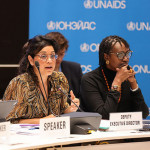World AIDS Day is a time to reflect on those we’ve lost to HIV/AIDS, as well as on how much progress we’ve made in the national response to HIV. It’s also an important opportunity to assess where we need to improve and what our next steps should be.
Our Successes
We continue to make progress toward achieving our goals of reducing new HIV infections, improving health outcomes among people living with HIV, and reducing some HIV-related disparities. Reaching these goals will require that we sustain the progress we have already made and accelerate efforts, efficiently and effectively, across HIV prevention, treatment, and care services and programs. Today, we have highly effective tools to help us continue and accelerate that trend. For example:
- Treatment as prevention (TasP): For people living with HIV, there are important health benefits to getting their viral load as low as possible. We have known for some time that those who know their status, take HIV medication daily as prescribed, and get and keep an undetectable viral load can live long and healthy lives. Now we also know that they have effectively no risk of sexually transmitting HIV to their HIV-negative partners. TasP benefits everyone!
- Pre-exposure prophylaxis (PrEP) is a once-daily pill that, when taken as prescribed, can protect HIV-negative people at high risk for infection. PrEP lowers the risk of sexual transmission of HIV by up to 90 percent and the risk of transmission via injection drug use by up to 70 percent.
Our Challenges
Despite the progress we’ve achieved, some populations and regions continue to fall behind. HIV stigma continues to be a major barrier to prevention, testing, and treatment, and HIV continues to affect certain groups of people more than others. They include men who have sex with men (especially young, black and Latino/Hispanic men), people who inject drugs, and transgender women. We must continue to focus our efforts on these key populations to ensure that they reap the benefits of our new HIV prevention and treatment tools.
We also need to ensure that people know about the benefits of getting and keeping an undetectable viral load and how PrEP can protect them from getting HIV. Right now, too many people—including healthcare providers—don’t know about TasP and PrEP, or they don’t realize how lack of access to these interventions is contributing to the ongoing epidemic. That’s why we need your help to spread the word about the benefits of these tools to your families, friends, colleagues, and healthcare providers.
Our Opportunities
We are currently in the process of updating the National HIV/AIDS Strategy (NHAS) and the National Viral Hepatitis Action Plan (NVHAP) as both strategies expire in 2020. These updates will integrate the latest scientific advances, focus on the most effective clinical practices, respond to new challenges that have emerged (e.g., the opioid crisis), and identify opportunities for integration across programs and services. The updates will help us continue—and expand—our hard-won progress, conserve resources, and reduce healthcare costs.
This World AIDS Day, please help us sustain the forward momentum of our response to HIV in the U.S. by:
- Getting tested and getting into care. Take control of your health by knowing your status. Visit the HIV.gov Testing Sites & Care Services Locator to find a convenient testing place and other services near you.
- Talking about HIV, TasP, and PrEP with those in your circle of influence. Tackle stigma and help us spread the word—and potentially save the life/health of people you care about.
- Providing your feedback and comments for updating the NHAS and NVHAP at our upcoming listening sessions. Stay tuned to HIV.gov for details!
Tammy R. Beckham, DVM, PhD, is Acting Director, Office of HIV/AIDS and Infectious Disease Policy, U.S. Department of Health and Human Services.
This article was originally published at HIV.gov.







Comments
Comments